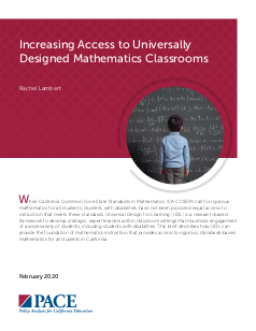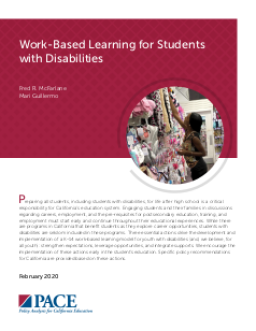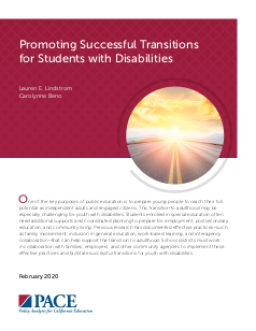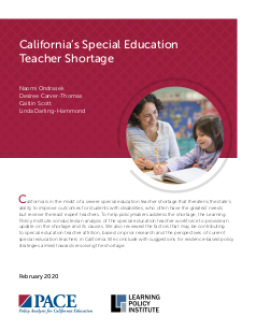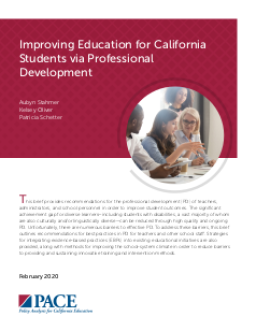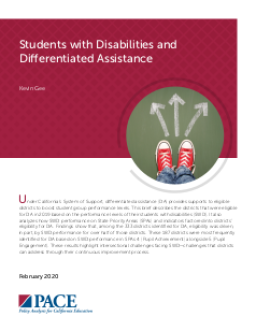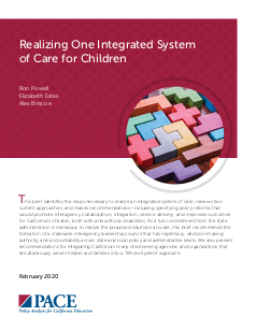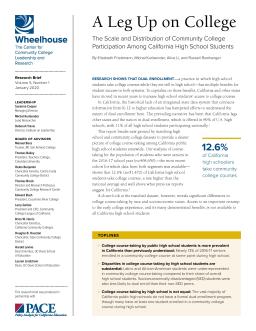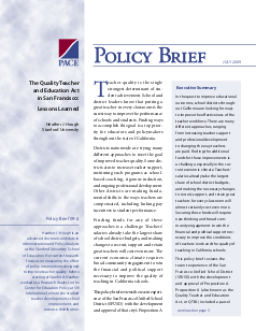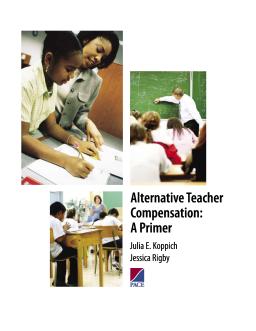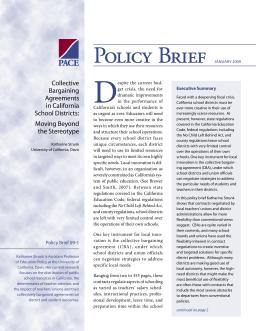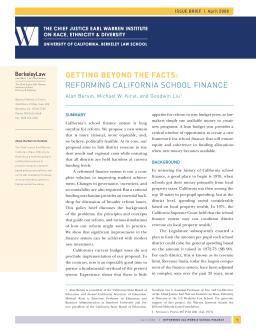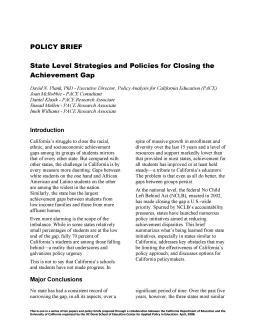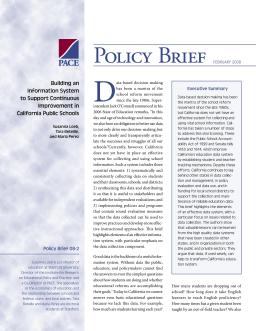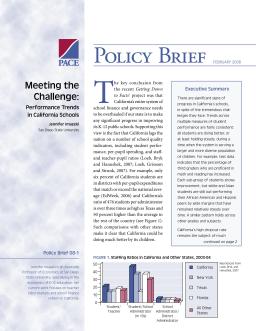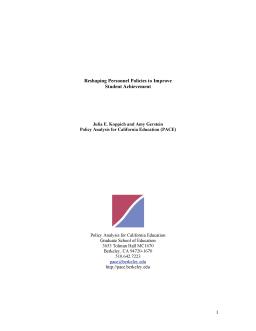Published
Summary
This brief explains that while the California Common Core State Standards in Mathematics require rigorous instruction for all students, those with disabilities do not always have equal access to this instruction. It recommends the use of Universal Design for Learning (UDL), a research-based framework that enables expert learners within classroom settings and maximizes engagement for all students, including those with disabilities, to provide access to rigorous, standards-based mathematics instruction for all students in California.
Published
Summary
Students with disabilities should be included in programs that prepare them for life after high school. This can be achieved through a K-14 work-based learning model, which involves strengthening expectations, leveraging opportunities, and integrating supports. Early implementation of these actions is encouraged, along with specific policy recommendations for California.
Published
Summary
Preparing youth with disabilities for adulthood can be challenging, requiring additional supports and coordinated planning. Effective practices, such as family involvement, inclusion in general education, and interagency collaboration, can facilitate successful transitions to employment, postsecondary education, and community living. School districts must work with families, employers, and community agencies to implement these practices.
Published
Summary
The Learning Policy Institute analyzed the special education teacher workforce in California and found a severe teacher shortage that could harm students with disabilities who need expert teachers the most. The report identifies the causes of the shortage and potential reasons for teacher attrition. Evidence-based policy strategies are suggested to address the issue.
Published
Summary
This brief suggests recommendations for improving student outcomes by providing high quality and ongoing professional development to teachers, administrators, and school personnel. It identifies the achievement gap for diverse learners, including culturally and linguistically diverse students with disabilities, and offers strategies for integrating evidence-based practices into existing educational initiatives. Additionally, it outlines methods for improving the school-system climate to reduce barriers to providing and sustaining innovative training and intervention methods.
Published
Summary
This brief discusses how California's System of Support uses differentiated assistance (DA) to provide support to districts and boost student group performance levels. It analyzes the districts eligible for DA in 2019 based on their students with disabilities' (SWD) performance on State Priority Areas (SPAs) and indicators. The findings show that over half of the 333 eligible districts were driven by SWD performance in SPAs 4 (Pupil Achievement) and 5 (Pupil Engagement), highlighting intersectional challenges facing SWD that districts can address through their continuous improvement process.
Published
Summary
This brief highlights California's Multi-Tiered System of Supports (MTSS), which assists struggling students. The inadequate resourcing of Tier 2 services is nevertheless preventing progress in reading and math, as California ranks 38th in the nation. Categorical funding is necessary to provide additional personnel, such as instructional aides and clerical staff, to assist teachers with implementing MTSS effectively.
Published
Summary
This brief outlines the necessary steps to integrate care systems and improve outcomes for California's children. It suggests forming a statewide interagency leadership council and recommends policy reforms to promote collaboration, integration, and service delivery. The goal is to create a "Whole System" approach that integrates child-serving agencies and organizations. A full commitment from the state administration is needed to achieve these solutions at scale.
The Scale and Distribution of Community College Participation Among California High School Students
Published
Summary
California has sought to increase high school students’ access to college courses through dual enrollment. This brief matches high school and community college datasets, revealing that 12.6% of state high school students take college courses, higher than the national average. However, Latinx and African American students, as well as socioeconomically disadvantaged students, were underrepresented in community college course-taking. The vast majority of California public high schools lack formal dual enrollment programs, limiting access to an important onramp to the early college experience.
Published
Summary
This brief examines the use of student test scores in teacher evaluations in CA. It argues that current evaluation methods are not effective, and that alternative methods of measuring teacher effectiveness, such as peer evaluations and student surveys, should be explored. The brief also discusses the potential consequences of over-reliance on test scores, such as teaching to the test and neglecting non-tested subjects. It concludes that teacher evaluations should be designed to provide useful feedback for professional development, rather than being used solely for accountability purposes.
Published
Summary
The brief discusses California's current school funding system and how it needs to be reformed to ensure equity and adequacy for all students. The current system is inadequate, unfair, and difficult to understand. The brief recommends a new system that is transparent, flexible, and based on student needs. The new system should also be aligned with state and local priorities, and provide incentives for districts to improve student outcomes. Finally, the brief emphasizes the importance of engaging stakeholders and building public support for the new funding system.
Lessons Learned
Published
Summary
This policy brief examines the recent development and approval of Proposition A in the San Francisco Unified School District, which included a parcel tax for increasing teacher salaries, introducing flexibility to the salary schedule, and strengthening accountability for teacher performance. The author describes how the district and union worked together to increase compensation and align school district goals with teacher salaries.
A Primer
Published
Summary
The report is a primer on alternative teacher compensation, which provides information about different models for teacher pay, and analyzes the benefits and challenges of each model. It highlights the reasons for the interest in alternative compensation, such as improving teacher quality, increasing teacher retention, and addressing teacher shortages. The report also examines the potential impact of alternative compensation on student outcomes, and offers recommendations for policymakers and practitioners considering implementing such programs.
Moving Beyond the Stereotype
Published
Summary
This brief examines how Collective Bargaining Agreements (CBAs) between school districts and teachers’ unions vary across California's 464 districts, suggesting that local flexibility is being used to solve specific problems. However, CBAs in high-need student districts are less likely to include unconventional provisions. The author suggests three policy levers the state can use to ensure local flexibility is used to benefit students: sharing best practices, incentives for innovation, and sanctions for abusing flexibility.
Continuous Improvement in California’s Education System
Published
Summary
This policy brief emphasizes the need for California's education system to become a continuously improving system that fosters innovation, measures the impact of policies and practices, and learns from experience. The authors identify key features of a continuously improving system, including clear goals, reliable data, change-supportive capacity, flexible decision-making, and aligned incentives. They explain how each of these features supports continuous improvement and highlight the differences between the current education system and a continuously improving one.
Reforming California School Finance
Published
Summary
This policy brief proposes a more rational and equitable school finance system for California that links district revenue to student needs and regional costs. The proposal aims to ensure that all districts are held harmless at current funding levels while providing essential backdrop for broader reform issues. The brief discusses the problems with the current finance system, the principles and concepts that guide the reform, and simulations of how it might work in practice. The report shows that significant improvement in the finance system can be achieved with modest new investment.
Published
Summary
California faces significant challenges in closing the achievement gap between different student groups, including wide disparities based on race, ethnicity, and socioeconomic status. While progress has been made, the gaps persist. This report summarizes what is being learned from state initiatives to reduce these disparities, addresses obstacles limiting effectiveness, and provides options for policymakers to address this urgent issue.
Published
Summary
This policy brief proposes policy recommendations to improve teaching quality in California schools by experimenting with new policies in professional development, evaluation, compensation, and teacher career structure. It includes descriptions of innovative programs in each area being implemented across the US. The state can play a critical role in providing incentives, evaluating effectiveness, and developing partnerships to share knowledge about effective policies and practices.
Published
Summary
California needs to improve its education data system to collect and use vital school information for continuous improvement. The state is behind in data collection, management, evaluation, and funding compared to other states. The report suggests learning from other high-quality data systems and using data to transform California's education system.
Performance Trends in California Schools
Published
Summary
California's education system faces financial and demographic challenges, with per pupil spending below the national average and a majority of students living in poverty or English Learners. However, recent state and national assessments show improved academic performance, particularly for poor and minority students. More students are taking advanced math and science courses and meeting university admission requirements. While the state falls short of its goals, systemic reforms are needed, but the gains are a result of hard work and commitment from California's educators.
Data Systems and Policy Learning
Published
Summary
This report advocates for a continuous improvement approach to education in California, emphasizing the need for a comprehensive data system to inform decision-making and evaluation at all levels of the education system. It also recommends the use of research-based practices and the development of partnerships between schools and community organizations to support student success. The report emphasizes the importance of equity and suggests strategies for addressing achievement gaps and providing more resources to under-resourced schools.
Published
Summary
This report examines personnel policies in California schools and their impact on teacher quality and student outcomes. It finds that many districts have ineffective policies and recommends reforms, such as performance evaluations and professional development. The report also emphasizes the need to attract and retain high-quality teachers, provide support for them, and promote collaboration between districts and unions.
How the First Semester Matters for Community College Students’ Aspirations and Persistence
Published
Summary
This policy brief argues that expanding access to community college alone will not prepare California's workforce for the 21st century. It shows that many high school graduates who enter community college with the goal of transferring to four-year colleges do not make it through their first semester with their goals intact. Providing additional guidance and support during the first semester could improve student persistence and transfer rates, as the first semester is crucial in shaping students' post-secondary academic careers.
Options for California
Published
Summary
This policy brief examines accountability in California's education system, calling for a comprehensive approach that measures student outcomes and addresses systemic factors. The authors emphasize stakeholder engagement and local capacity building, and suggest a balanced approach that promotes continuous improvement for California's diverse student population.
Options for California
Published
Summary
This policy brief advocates for the expansion of career-technical education (CTE) in California's high schools through a CTE/multiple pathways approach. The authors argue that this approach integrates academic and occupational content, is more effective for students, and addresses criticisms of high schools. They propose building on existing CTE practices and providing funding, technical assistance, professional development, curriculum development, work-based learning opportunities, and data monitoring to support the expansion of CTE/multiple pathways.
